Architecture- La montée de l'architecture organique
Blobitecture – The Rise of Organic Architecture
 |
| Projet de musique d'expérience, Seattle, Image Darwin de Bell |
They might perhaps be at risk of coming across like characters in a scene from a certain Monty Python film, but some people still insist on asking the question what have computers ever done for us? One mooted answer could certainly be blobitecture (or, blobism, blobismus or blob architecture) for this architectural term could not have become reality without them.
Pourtant, ce qui est blobitecture? Il est un terme pour une école d'architecture dans lequel les formes organiques sont le but, exorbités, cellulaires, des bâtiments amibes son expression. Bien que le terme ne semble pas en version imprimée qu'en 2002, l'architecture blob avait été utilisé comme une expression dans les milieux architecturaux depuis le milieu de la décennie précédente. Il a notamment été le New York Times qui a d'abord amené à une plus grande attention, dans le cadre de William Safire Sur la colonne de la langue.
 |
| Selfridges, Birmingham Royaume-Uni - Image Mags_cat |
 |
| Selfridges, Birmingham Royaume-Uni - image Wojtek Gurak |
 |
| Selfridges, Birmingham UK - Image de Wojtek Gurak |
Yet what is blobitecture? It is a term for an architectural school in which organic shapes are the aim, bulging, cellular, amoeba-like buildings its expression. Although the term did not appear in print until 2002, blob architecture had been used as an expression in architectural circles since the middle of the previous decade. Notably it was the New York Times which first brought it to greater attention, as part of William Safire’s On Language column.
Safire n'a pas utilisé le terme poliment. Cependant, c'était un mot qui, grâce à son dénigrement de la forme, ont décollé et sont venus à définir. Pourtant, le changement des définitions et quand Safire a lancé sur le reste du monde, il la parole (et la forme que les gens l'ont vu) allaient évoluer.
 |
| Guggenheim Bilbao, Image dyangchi |
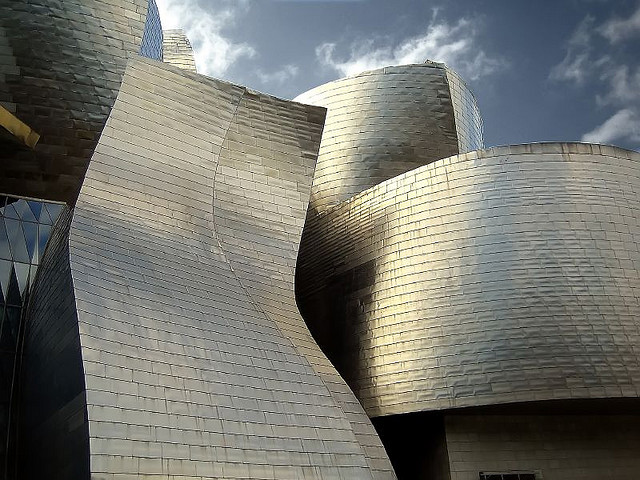 |
| Guggenheim Bilbao, Image Cuellar |
Safire did not use the term politely. However, it was a word that, thanks to his denigration of the form, took off and came to define it. Yet definitions change and when Safire launched it on to the wider world it the word (and the form as people saw it) would evolve.
Blobitecture se distingue des autres formes architecturales comme entièrement créée à partir de la conception assistée par ordinateur (CAO). Architectes emploient CAD pour contrôler les contours des bâtiments de pratiquement n'importe quelle forme. Pour leur permettre de faire cela, le logiciel calcule automatiquement équations mathématiques qui implant précision structurelle et de fiabilité dans la conception. Avant l'échéance du CAD comme un outil, les architectes sont restés sous l'emprise d'un caractère géographique conventionnel car ils étaient certains que ces formes ont une stabilité structurelle. Maintenant, grâce à un logiciel de CAO, la forme d'un bâtiment a un potentiel illimité.
 |
| Le Sage, Gateshead Royaume-Uni - image alephnaught |
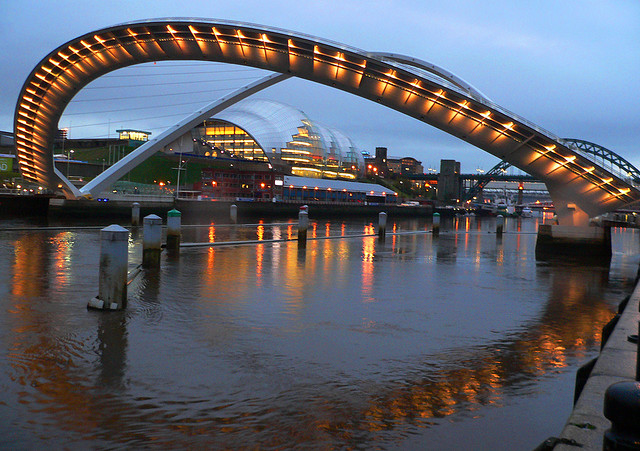 |
| Millennium Bridge et The Sage, Gateshead Royaume-Uni - Image de Simon et Vicki |
 |
| Le Sage, Gateshead YK - image hap |
Blobitecture is distinct from other architectural forms as it wholly created from computer-aided design (CAD). Architects employ CAD to control buildings' outlines to practically any form. To enable them to do this, the software automatically computes mathematical equations that implant structural accuracy and dependability into the design. Before CAD's maturity as a tool, architects remained in thrall to a conventional geographical character as they were certain that these shapes had structural stability. Now, thanks to CAD software, the shape of a building has unlimited potential.
Nous avons architecte Greg Lynn à remercier pour la durée initiale - il a inventé en 1995 pour donner la définition de ses expériences en matière de conception numérique. Il a utilisé le logiciel metaball, la technique qui avait été inventé par Jim Blinn (un informaticien NASA) dans les premières années des années 1980. Cette modélisation Dupont (termes réels) a permis la création d'objets à n dimensions organique prospectifs, où n est le nombre de dimensions (généralement 2 ou 3) est mesuré.
We have architect Greg Lynn to thank for the original term – he invented it in 1995 to give definition to his experiments in digital design. He used metaball software, the technique for which had been invented by Jim Blinn (a NASA computer scientist) in the first years of the 1980s. This blobby modelling (real term) enabled the creation of organic-looking n-dimensional objects, where n is the number of dimensions (usually 2 or 3) being measured.
Lynn a utilisé le terme comme un substitut de forme biomorphique, dérivant d'une sorte d'acronyme à partir d'une description technique d'une forme informatique formé - un grand objet binaire. Il a envisagé architectes blob découvrir une nouvelle forme de splendeur, de sophistication et d'élégance dans la forme voluptueuse, cadencé et vallonné du calcul différentiel.
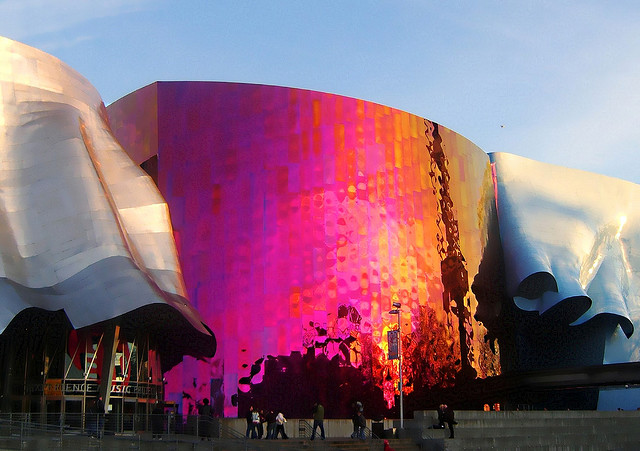 |
| Experience Music Project, Seattle - Image de Darwin de Bell |
 |
| Projet de musique d'expérience, Seattle - Image de J-Bird en K-Town |
 |
| Projet de musique d'expérience, Seattle - image Selva |
We have architect Greg Lynn to thank for the original term – he invented it in 1995 to give definition to his experiments in digital design. He used metaball software, the technique for which had been invented by Jim Blinn (a NASA computer scientist) in the first years of the 1980s. This blobby modelling (real term) enabled the creation of organic-looking n-dimensional objects, where n is the number of dimensions (usually 2 or 3) being measured.
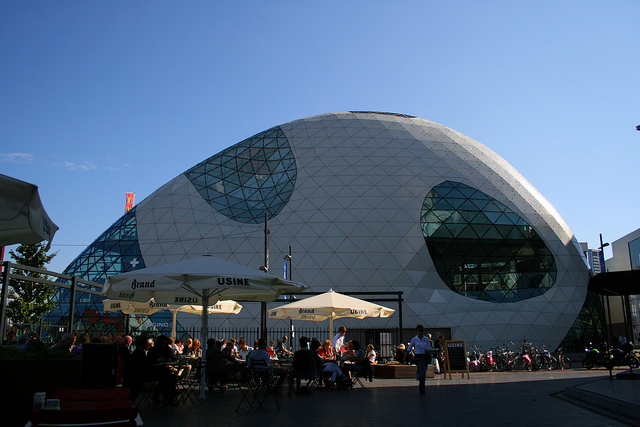 |
| Le Blob, Eindhoven Pays-Bas - image Andrew B47 |
| Le Blob, Eindhoven Pays-Bas - Truss de l'image, Bob + Jan trop |
Lynn used the term as a substitute for biomorphic form, deriving it from a kind of acronym from a technical description of a computer-formed shape - a binary large object. He envisioned blob architects discovering a new form of splendor, sophistication and elegance in the voluptuous, cadenced and undulating shape of differential calculus.
Dit simplement, sans conception assistée par ordinateur, blobitecture serait impossible - tout comme les nouvelles et inhabituelles formes que les architectes et les concepteurs de meubles ont été des expériences avec peu de temps après Lynn. Les manipulations des algorithmes nécessaires pour obtenir les formulaires sont impossible à faire sur papier.
Put simply, without computer-aided design, blobitecture would be impossible – as would the new and unusual forms that architects and furniture designers were experimenting with shortly after Lynn. The manipulations of the algorithms needed to derive the forms are impossible to do on paper.
Pourtant, si vous affichez blob architecture de l'idée de la forme plutôt que celle de la technologie, il ya certainement des précédents - et les bâtiments qui rempliraient votre définition. Projets par Buckminster Fulller, célèbre pour dômes géodésiques, ont le style et la structure qui sera plus tard associé à l'architecture blob. L'anglais Archigram groupe architectural s'est intéressé à des formes qui pourraient être créés à partir de plastique ou même gonflés. Leurs idées seraient probablement considérées comme blob par au moins le profane.
Yet if you view blob architecture from the idea of form rather than that of technology there are certainly precedents – and buildings that would fill your definition. Projects by Buckminster Fulller, famous for geodesic domes, have the style and structure which would later be associated with blob architecture. The English architectural group Archigram was interested in shapes that could be created from plastic or even inflated. Their ideas would be likely looked upon as blob by at least the layman.
Un membre d'Archigram, Peter Cook, irait à être à l'avant-garde de l'architecture blob avec le Musée d'art de Graz (Autriche) en 2003. Ce bâtiment et d'autres ont pris la définition de l'architecture blob de son original, si étroite, l'interprétation - qu'il devait naître uniquement des techniques de modélisation informatique.
A member of Archigram, Peter Cook, would go on to be at the forefront of blob architecture with the Graz Art Museum (Austria) in 2003. This building and others has taken the definition of blob architecture from its original, if narrow, interpretation – that it was to be born solely from computer modeling techniques.
Avec toute définition, il faut aller avec l'esprit du temps. Significations changent et maintenant blobitecture est associé beaucoup plus largement que l'idée originale de Lynn. En fait, tout bâtiment en forme ou à la recherche étrange est souvent désigné comme un exemple de la forme, qui tout en n'étant pas correcte, est juste en termes de la définition populaire du mot.
Ceci en dépit du fait que le logiciel avancé de conception assistée par ordinateur a été utilisé dans leur conception. CATIA a particulièrement contribué à la conception de deux bâtiments. Cela signifie Assistée par Ordinateur application interactive en trois dimensions et est un multi-plateforme CAD / CAM / suite logicielle commerciale CAE développé par la société française Dassault Systèmes. Il est commercialisé dans le monde entier par IBM.
Technically the first building designed through pure blob architectural techniques was the Water Pavilion, a temporary structure in Holland which stood from 1993 – 1997. It was built by Lars Spuybroek (NOX) and Kas Oosterhuis and was of a fully computer based nature. Its interior was fully electronically interactive – light and sound could be changed by visitors.
Un autre bâtiment qui est considéré comme blob architecture sont l'Allianz Arena par Herzog et de Meuron. Norman Foster s'est également impliqué avec blob architecture, avec sa conception de la Bibliothèque philologique à Berlin ainsi que le Sage Gateshead qui à la fois ouvert ses portes en 2004.
Comme les architectes rompent plus libre à partir de formes géométriques traditionnels, on s'attend à blobitecture de devenir un aspect plus familier des paysages urbains mondiaux. CAD est capable de produire des formes illimitées de blob architecture et de nombreux architectes motivés profitent des limites apparemment illimitées de blobism de pousser l'architecture à ses dernières limites.
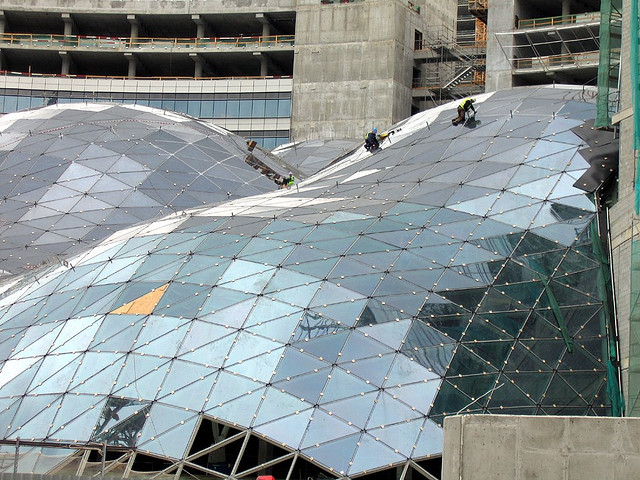 |
| Zlote Tarasy à Varsovie Pologne - Image de Zlote Tarasy |
 |
| Zlote Tarasy à Varsovie Pologne - image Wasilka |
 |
| Zlote Tarasy à Varsovie Pologne - image Access.Denied |
Put simply, without computer-aided design, blobitecture would be impossible – as would the new and unusual forms that architects and furniture designers were experimenting with shortly after Lynn. The manipulations of the algorithms needed to derive the forms are impossible to do on paper.
 |
| City Hall, Londres - image Kol Tregaskes |
 |
| City Hall, Londres - image Dmitry B |
 |
| City Hall, Londres - image K_Gradinger |
Yet if you view blob architecture from the idea of form rather than that of technology there are certainly precedents – and buildings that would fill your definition. Projects by Buckminster Fulller, famous for geodesic domes, have the style and structure which would later be associated with blob architecture. The English architectural group Archigram was interested in shapes that could be created from plastic or even inflated. Their ideas would be likely looked upon as blob by at least the layman.
 |
| Graz Art Musem, Graz Autriche - image rpeschetz |
 |
| Musée des Arts Graz, Graz Autriche - image Watz |
 |
| Musée des Arts Graz, Graz Autriche - image Identity Chris Est |
A member of Archigram, Peter Cook, would go on to be at the forefront of blob architecture with the Graz Art Museum (Austria) in 2003. This building and others has taken the definition of blob architecture from its original, if narrow, interpretation – that it was to be born solely from computer modeling techniques.
 |
| Aqua Tower, Chicago - image ChicagoGeek |
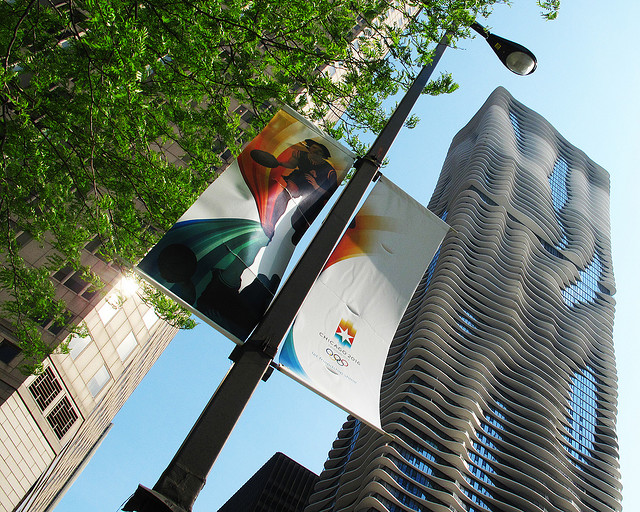 |
| Aqua Tower, Chicago - Image de John Picken |
 |
| Aqua Tower, Chigo - Image de John Picken |
With any definition, one must go with the zeitgeist. Meanings change and now blobitecture is associated much more widely than Lynn’s original idea. In fact any odd shaped or looking building is often referred to as an example of the form, which while not being correct, is right in terms of the popular definition of the word.
Frank Gerhy a pris à l'architecture de Blob en 1997 avec son design pour le musée Guggenheim de Bilbao et a suivi avec EMP | SFM (connu sous le nom de projet de musique d'expérience pour faire court) en 2000. Pourtant, bien que celles-ci seraient à l'œil non averti regarder la quintessence de l'architecture blob, suite à son étroit des définitions, elles ne sont pas. La raison? Ils ont été conçus en utilisant des modèles physiques plutôt que des manipulations informatiques.
 |
| Projet de musique d'expérience, Seattle - image Selva |
 |
| Guggenheim Bilbao - image Le monstre français |
Frank Gerhy took to Blob architecture in 1997 with his design for the Guggenheim Museum Bilbao and followed it up with EMP|SFM (known as the Experience Music Project for short) in 2000. Yet although these would to the untrained eye look the epitome of blob architecture, following its narrowest of definitions, they are not. The reason? They were designed using physical models rather than computer manipulations.
 |
| Dancing House, Prague - image gdelargy |
 |
| Gare de Seine, Paris - Image de Alexandre Vialle |
This is despite the fact that advanced computer-aided design software was used in their design. CATIA was particularly instrumental in the design of both buildings. This stands for Computer Aided Three-dimensional Interactive Application and is a multi-platform CAD/CAM/CAE commercial software suite developed by the French company Dassault Systemes. It is marketed worldwide by IBM.
Techniquement, le premier bâtiment conçu par des techniques d'architecture blob pur a été le Pavillon de l'eau, une structure temporaire en Hollande qui était de 1993 à 1997. Il a été construit par Lars Spuybroek (NOX) et Kas Oosterhuis et était de nature informatique entièrement. Son intérieur a été entièrement interactif électronique - lumière et le son peuvent être modifiées par les visiteurs.
 |
| Bibliothèque philologique, Berlin - Image de maha-ligne |
 |
| Bibliothèque philologique, Berlin - Crédit d'image Jonas_K |
Technically the first building designed through pure blob architectural techniques was the Water Pavilion, a temporary structure in Holland which stood from 1993 – 1997. It was built by Lars Spuybroek (NOX) and Kas Oosterhuis and was of a fully computer based nature. Its interior was fully electronically interactive – light and sound could be changed by visitors.
 |
| Allianz Arena, Munich - image Trodel |
 |
| Allianz Arena. Munich - image dloop |
Another building that is considered blob architecture are the Allianz Arena by Herzog and de Meuron. Norman Foster has also involved himself with blob architecture, with his design for the Philological Library in Berlin as well as the Sage Gateshead which both opened in 2004.
 |
| Musée des Arts Graz, Graz Autriche - image Weiko |
As architects break further free from traditional geometrical shapes, blobitecture is expected to become a more familiar aspect of global cityscapes. CAD is able to produce unlimited forms of blob architecture and many motivated architects are taking advantage of blobism’s seemingly unlimited boundaries to thrust architecture to its farthest limits.